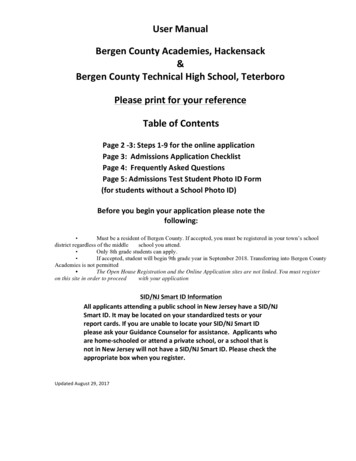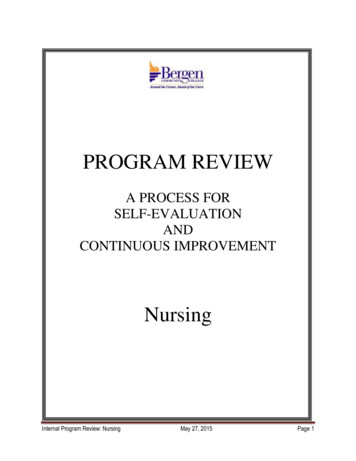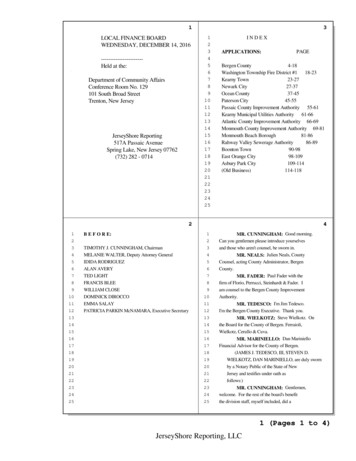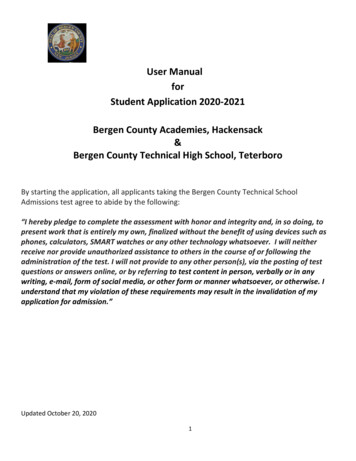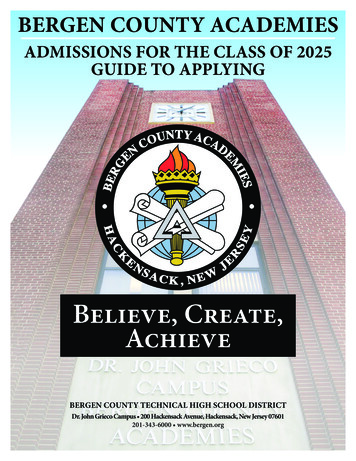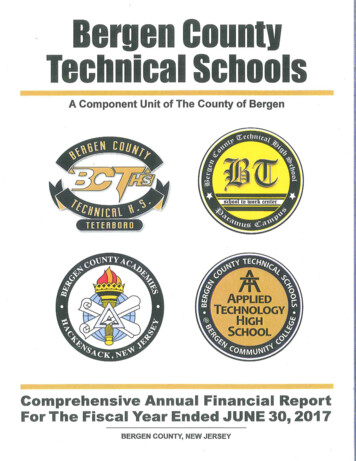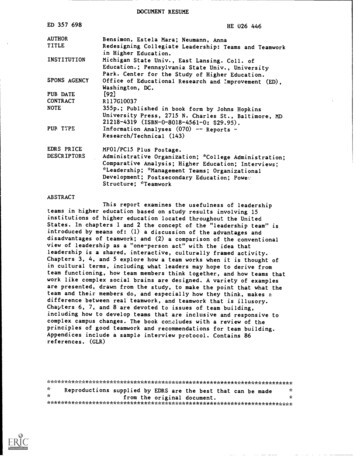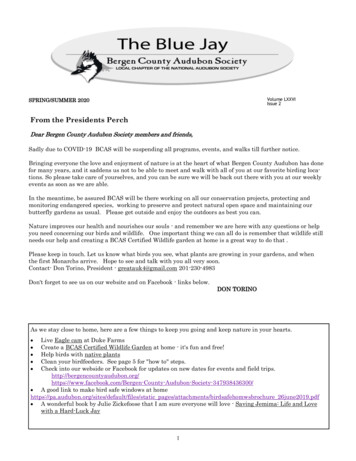
Transcription
Volume LXXVIIssue 2SPRING/SUMMER 2020From the Presidents PerchDear Bergen County Audubon Society members and friends,Sadly due to COVID-19 BCAS will be suspending all programs, events, and walks till further notice.Bringing everyone the love and enjoyment of nature is at the heart of what Bergen County Audubon has donefor many years, and it saddens us not to be able to meet and walk with all of you at our favorite birding locations. So please take care of yourselves, and you can be sure we will be back out there with you at our weeklyevents as soon as we are able.In the meantime, be assured BCAS will be there working on all our conservation projects, protecting andmonitoring endangered species, working to preserve and protect natural open space and maintaining ourbutterfly gardens as usual. Please get outside and enjoy the outdoors as best you can.Nature improves our health and nourishes our souls - and remember we are here with any questions or helpyou need concerning our birds and wildlife. One important thing we can all do is remember that wildlife stillneeds our help and creating a BCAS Certified Wildlife garden at home is a great way to do that .Please keep in touch. Let us know what birds you see, what plants are growing in your gardens, and whenthe first Monarchs arrive. Hope to see and talk with you all very soon.Contact- Don Torino, President - greatauk4@gmail.com 201-230-4983Don't forget to see us on our website and on Facebook - links below.DON TORINOAs we stay close to home, here are a few things to keep you going and keep nature in your hearts. Live Eagle cam at Duke FarmsCreate a BCAS Certified Wildlife Garden at home - it's fun and free!Help birds with native plantsClean your birdfeeders. See page 5 for "how to" steps.Check into our webside or Facebook for updates on new dates for events and field 6300/ A good link to make bird safe windows at tic pages/attachments/birdsafehomwsbrochure 26june2019.pdf A wonderful book by Julie Zickefoose that I am sure everyone will love - Saving Jemima: Life and Lovewith a Hard-Luck Jay1
BERGEN COUNTY AUDUBONSOCIETY—Officers, Directors & CommitteeChairpersonsPRESIDENT: Don Torino201-230-4983VICE PRESIDENT: Marilyn Sadowski201-9820483TREASURER: Dave & Nancy Hall973-226-7825RECORDING SECRETARY: Patrice Torino201-414-0534CORRESPONDENCE SECRETARY:Julie McCall 201-639-4647FIELD TRIPS: Chris Takacs201-207-0426BLUE JAY: Nancy Salvati201-840-0542PUBLICITY, WEBMASTER:Alicina Memar 201-747-5651CONSERVATION CHAIR: Karen Nickeson201-886-1748EDUCATION: Marie Longo201-498-0809LEGISLATION: Dave Hall973-226-7825FIELD WORK: Dave Hall973-226-7825FUNDRAISING: Peggy O’Neill201-868-5829MEMBERSHIP: Joseph Koscielny201-337-3405Published quarterly by the Bergen CountyAudubon Society, a chapter of the NationalAudubon Society.Send articles to PO Box 235, Paramus, NJ07653-0235 or email editor, Nancy Salvatiat nancys@nj.rr.com.CANCELLED BCAS BUS TRIPTO SAGAMORE NATIONAL PARK.As you may know, this bus trip has beencancelled.Nancy Hall has been trying to reach peopleand send them refund checks. Anyone whopaid for the trip but has not yet received arefund should e-mail or phone Nancy withtheir street address.You can email her at:nancyrhall71@gmail.com orcall at 973-226-7825MEMBERSHIP CHAIRJoe KoscielnyFirst of all, I want to thank all of you for your continued support. Without you we would not be able to continue to run ourprograms and field trips for free.Secondly, if you are not receiving our current e-mail reminderalerts about upcoming events, field trips and programs, it isimportant that you go to our website http://bergencountyaudubon.org/.Click on the EMAIL LIST tab and fill out required info.This way, not only will you receive reminders but also information on any changes such as cancellations and rescheduling.This is especially important because of the current pandemicrestrictions. Thank you and be safe.IN MEMORIAMMemories shared by two of our membersPeg Dalton, a long time BCAS member, passed away March 29th aftersuffering a stroke. Those who recall Peg will remark that she was always smiling, always laughing. I remember her as endlessly curiousand adventurous. In my bird outings with her, there was never a ‘notrespassing’ sign that she was able to comprehend. And when she wascaught, she was able to disarm the meanest property guard. She was akeen birder, ready at the earliest hour, make-up and earrings on, thermos in hand, always good company. There was delight in every discovery.Peg loved her BCAS community and contributed wherever she could.She thrived on learning and expanding her world. On her last healthyday, she was exploring Facetime in order to join a class remotely. Sheprodigiously loved her family and friends. I will always admire hervaliant spirit.-Karen NickesonWhen Peg Dalton comes to mind I smile. Whether on a walk with Bergen County Audubon, Greenbrook, or at Cape May, she always had aready smile. I especially recall her dedication to the ChristmasCount!! In December 2013 very few people showed up at the OverpeckPark; Peg did. It had snowed the night before, and unbeknownst to usthe parking lot had frozen over with a thick sheet of ice. All we sawwas a deceivingly beautiful freshly falling layer of snow covering theparking lot. Peg and I walked across that empty lot to better observesomething with feathers. BAM! POW! We both slipped on the hiddenice, went up in the air and down again, landing flat on our backs. Oncewe realized we were both OK we laughed hysterically and hoped wewould be recognized for our dedication to citizen science and the Bergen County Christmas Count!-Brenda McintyreThe Board of BCAS shares in these wonderful memories andwants to express its deepest sympathies to Peg's family.* * * *To read the entire obituary and if you want to post a tribute,please go to tDalton/obituary.html2
CONSERVATIONKaren Nickeson, ChairThe “Goldilocks” Bird -- Is it Just Right?Next time you visit Overpeck, take a look to the east as you pass the rotary with the flagpole. You will observe a splendid new array of Purple Martin houses waiting for residentsto move in. Purple Martins are notoriously tricky to attract. If you build it, they still maynot come. Proximity to human-built structures is a positive. Habitat for predators willspook them. So will trees taller than the nesting structure. The most critical element istiming. Martins tend to develop site fidelity, returning to the same location each spring.New nesting structures attract subadult birds who have never established a colony. Firsttime nest builders typically arrive 4-5 weeks after the mature birds and their “scouts.”The art of timing involves knowing when to open the entrance to the gourd-shaped nest. As I write this, the nestopenings are closed with tape. This is to prevent House Sparrows and other birds from claiming the houses before the arrival of the Martins. If the openings remain closed too long, we miss the young birds that are cruisingfor new homes. Fortunately, the Purple Martin Conservation Association records migration sightings at purplemartin.org. If you visit the website you will be treated to delightful NestCam footage of these charismatic birds,the history of human nest management, and the up-to-date mapping of their migration.So please, as you pass the Martin houses, do a little welcome dance, prayer, incantation of your choice in hopes ofseeing these beautiful creatures move in.Acknowledgments: BCAS purchased the nesting structure with the help of membership contributions.Thanks to Mike Mongone, Certified Grounds Manager, along with his crew, including Andrew Forester, Trevor Williams, and Omar Perkins for their help inthis and all our Overpeck projects.If you see any one of them working around the park, please give them a wave andthanks. Jim Macaluso is generously donating his time and labor to manage theproject. He devoted days altering the gourds to make them starling proof, assembling the structure, and adding the mechanism to raise and lower the pole.Jimmy and Andrew did yeoman’s work erecting the structure on the toughremediated surface.More Conservation projects:BERGEN COUNTY GOLF COURSE BLUEBIRD PROJECTOur partnership with Bergen County Parks is continuing this Spring as wemonitor and install more nest boxes on our County golf course . Golf coursesare some of the last habitats in the county for the Eastern Bluebirds andproviding nesting places for them is critical to maintaining their population inour area. Many thanks to Chris Takacs and Rich Greendyk for taking charge ofthis important conservation project.3
2020 BCAS BACKYARD SPRING COUNT ON MAY 9ENJOY SPRING MIGRATION AT HOME!Bergen County Audubon Society has conducted a spring bird count for the past 25 years, coinciding with International Migratory Bird Day. The current turmoil caused by COVID-19 requires a change of plans. We still hope for our members and friends to appreciate the springbird migration, but in a safe manner.On Saturday May 9 we ask you to get outside and to monitor the birds locally, in your own yardor local neighborhood. Please obey the guidelines for social distancing. We encourage you to either postyour list to eBird. For those new ( htings-on-ebird).Or send back your observations to David Hall by email.We can send you a tally list by email if requested. As in previous years, we hope to monitor whichspecies, and how many birds for each species, are present in our region on May 9, 2020. We are interested in birds in all of Bergen County and in any other localities nearby. When you sendback your list, please let us know what town you live in. We do not need your address, just the town. Iwill compile a complete list of all the species that our members and friends find on that day. Based onthat number, we will ask for donations to BCAS, making this event a “Bird-a-thon” on behalf of ourchapter.We cannot be sure what the weather will bring on May 9, but the event is ON, rain or shine. Hopefullythis activity can bring some joy to our lives, despite the difficult circumstances.Have fun out there, and please stay safe!DAVID HALL david.hall@einsteinmed.orgIn recognition of these challenging times, please note theguidelines above from Dave Hall. You may pledge "X" amountper species and your donation will be multiplied by the totalnumber of species seen on that day, or you can pledge/donatea fixed amount. Your donation is fully taxdeductible. Checks should be made payable to BergenCounty Audubon Society.1. Mail form/check to BCAS Spring FundraiserP.O. Box 235Paramus, NJ 07653-0235 or2. Use the donate button at www.bergencountyaudubon.org.We appreciate any donation you can make and if your financial situation is limited we appreciate that too,but hope you can still go birding and help with the data collection and enjoy the spring migration .Pledge- per species amountor check amountNameAddressTel. #Contact Peggy O'Neill at (201)868-5829 for questions4
MAKING A DIFFERENCE – A columndedicated to all those member volunteers who in some way have enhanced, preserved, conserved, protected, educated or elevated our experiences of those things we love, the beauty of the natural world. The Editor.Thanks to Volunteer, ALEXA FANTACONE.She joined Teaneck Creek as the Executive Director in June 2015. She is responsible for volunteer management, recruitment and outreach, physical oversight of the 46 acres, program and event development, the organizations fundraising and finances, and all of the Conservancy's communication and socialmedia. Her accomplishments at Teaneck Creek include the Rain Barrel WaterHarvest System, various new art installations at the park, and concept designfor great new successful programs (like Bats and Brews and the home-schooltrifecta program. Photo of Alexa teaching in the LabyrinhThe Home-school trifecta is a cooperative program with Flat Rock Brook (FRB) and Tenafly Nature Center(TNC). It's a homeschool program for kids 6-12 on various topics.Alexa explains the Trifecta this way. "Home-schooled students aged 6-8 and 8-12 are welcome to join educators from Tenafly Nature Center, Flat Rock Brook, and Teaneck Creek Conservancy as we introduce yourhome school explorers to a plethora of plants and the interesting world of insects. Each month explorers willdiscover a new locale that is a part of beautiful Bergen County and explore the hidden gems within. Topicswill range from basic botany to identifying aquatic macro-organisms and will feature hands-on/minds-onexploration perfect for a budding to intermediate naturalist. Meet other home school families while kidsstrengthen their knowledge and appreciation for the environment."In her spare time, Alexa is an aviary volunteer at Flat Rock Brook Nature Center, chairs the Nature Program Cooperative, and has been a part of several national demonstrations for a healthy planet (March onClimate, DC; March on Climate, NYC; Keystone XL, DC).DEAR BCAS BIRDLOVERS.There are a few things we can do outside to occupy us while we wait out thisterrible virus and stay home. We can clean our feeders.I usually wait till our BCAS June Cleaning at Wild Birds before checkingmine but recently my finch feeder had a whitish film around the insidebottom of it. I immediately took it down and proceeded to empty it andsoak in a soapy pot then dunked in a 1-9 bleach solution.Some of the more common diseases that birds can spread through feedersinclude house finch eye disease (the colloquial name for mycoplasmal conjunctivitis, which can infect more than just the bird for which it’s named),salmonellosis and aspergillosis (a fungal respiratory disease), and avian pox.To prevent the spread of illness in the birds that frequent your seed buffet, try these three steps:1. Clean feeders regularly. Rinse the feeder well with soapy water, then dunk it into a bleach-watersolution. “A monthly cleaning with a nine-to-one water-bleach solution will deter bacteria in plastic, ceramic,and metal feeders . “A dilute vinegar solution (three-to-one) or non-fragranced biodegradable soap should beused on wood to minimize fading.” Dry out the feeder before hanging it back up. Double the frequency of cleaning if you suspect disease a-lurking.2. Tidy below the feeder. This can mean raking or shoveling up feces and hulls (seed casings)—particularly those that are moldy, wet, or spoiled—and throwing them out , “Bird food scattered on the groundalso can attract rodents.”3. Share the wealth. Spread out food among a couple feeders so there’s less opportunity for sick birds totouch and contaminate each other. “Crowding only expedites the spread of disease,” the Audubon guide reads,“so give the birds variety and plenty of room.”Let me know how it goes, Nancy Salvati ,email nancys@nj.rr.com5
EDUCATIONMarie Longo, ChairAudubon Adventures-Welcome to our newest school, Wildwood Elementary School in Mountain Lakes.They have also requested an Owl Nature Discovery Kit.Monarch Butterfly-Last season (2019-2020), the monarch populations reported in Mexico were down 53%as compared to the previous season. The monarch populations reported in Mexico (2018-2019) were considerably higher than the previous season (2017-2018) and it seemed the population was on the rebound.Habitat loss, climate change and illegal logging in Mexico all contributed to the decline. This only provesthat we must do all that we can to support these remarkable creatures and not take a “good” year forgranted.Planting native milkweed plants, native nectar sources and especially late blooming native nectar sourcescan make all the difference for the monarch. If each person planted just one milkweed plant, whether it bein a pot or a garden bed, imagine the impact we could have on the population of these marvelous butterflies. Plant milkweed!During this stressful, unsettling time, I encourage you to get outdoors. Whether it be in your backyard orlocal park, nature can make all the difference in the world. Migration is underway, creatures are emerging from their winter hibernation and signs of spring are all around us.Get outside and enjoy the beauty of nature unfolding.BIRDS, BEES AND BUTTERFLIES, OH MY!! IT’S TIME TO CERTIFYDuring these uncertain times, there is one certainty; migration is underway, spring has sprung and signs oflife are everywhere. Birds, bees and butterflies are appearing in our area and Bergen County AudubonSociety welcomes the opportunity to help you make a difference by certifying your garden.BCAS has certified 147 gardens thus far. Homeowners, schools, businesses, places of worship, nature centers, apartments, parks/communities are all invited to participate in this free program. Our Certified Wildlife Garden Program is based primarily on the number of native plants in your garden, but we also ask thatyou also provide: water sources-important for drinking and bathing cover-provides shelter from inclement weather and predators places to raise young-for courtship behavior and to safely raise young feeders (optional)Simply put, native plants provide the basic foods for wildlife and create better biodiversity, invasive plants destroy habitats and spread. You may visit the NationalAudubon Society native plant database to learn which native plants are recommendedfor planting in your area.Visit the native plant database at: audubon.org/plantsforbirds.Butterflies, bees and wildlife populations are suffering due to the lack of habitat. Our goal is to create stepping stones in between the vast landscape of homes, shopping malls, corporate buildings and asphalt.Applications and additional information can be found on our website: bergencountyaudubon.org/cwg/Questions? Contact:Marie Longo (201) 498-0809 MLongo8383@aol.comDon Torino (201) 230-4983 greatauk4@gmail.comKaren Nickeson (201) 304-3575 knickeson@hotmail.com.There is no better place to restore your spirit and nourish your soul than being outdoors!!6
A GRACKLES STORYBy DON TORINOIt seems that the only time I hear comments concerning the Common Grackle is whenthe evening news portrays them as swarming hordes of creatures bent on pecking youreyes out like from an old Alfred Hitchcock movie or when I get calls from home ownersthat are feeding the birds and want to know how to make them just go away and stopeating all their bird food. Well let me just start off by saying I LOVE GRACKLES! Yes,I said it! I really do love the Common Grackle. Despite all their negative PR I relish thedays when the Grackles covered my backyard, flocks descended upon the forests filling itwith the loud buzzing calls and yes, even those upset phone calls when I got to tell folksthat grackles are so very Cool and they should be enjoyed.Now I am not going to try to win you over by telling you how beautiful the Grackle really is with their wonderful glossyblue iridescent colors and Golden eye which gives them a very cool intense look or tell you about some of the very unusualthings they eat like crayfish, leeches off of turtles, frogs, mice and much less popular other birds (pretty neat dependingupon who you are). But what I am going to tell you is my own personal Grackle story that I hope will make you see Grackles in a new and better way from now on:It was a beautiful sunny Mother’s Day afternoon in the backyard of my Wife Pat’s family home in Oakland. As everyonesat there talking about the family news of the day a Grackle flew into a nearby cedar and as grackles do started to soundoff loudly. But this grackle seemed much more distressed, its cries were loud enough to bring it to the attention of eventhe many non-birders that relaxed on the deck trying to talk over the now louder cries of this big black bird. “Don, what’sthat bird want?” someone asked me as if I could wave my hand and quiet it down. So now my curiosity made me approachthe bird closer as I knew just from its erratic unusual call something was not right but as soon as I got close the bird flewacross the street to a nearby pond. Ok I said to myself that is that, the bird is gone which now would just leave me guessing to the grackles situation. But no sooner did I sit back down the same grackle retuned calling out even louder this timeto the attention of everyone at our Mother’s Day celebration. So once again at everyone’s urging -as if I am the bird whisperer- I again approached the bird calling from the cedars. But again as I approached it flew from the tree across thestreet to the pond while still calling and crying away. And now for the second time I sat ba ck down more puzzled than ever. What did that bird want? I looked for a nest in the cedar tree that I thought it may be protecting but nothing there andnow totally puzzled I sat back down and tried to enjoy the sun and the family talk but that did not last long.Now for a third time the Grackle returned, screaming, wings flapping with a sound of more desperation recognizable tothe birder and the non-bird lover alike and again as I approached it made a beeline across the street and to the pond. Thistime I decided to follow this poor bird as best I could to maybe see what the worry and fear that seemed to grip this creature was all about.The continued cry of the grackle went nonstop as I crossed the street to the pond but now suddenly I heard two birds oneseeming higher pitched but just as desperate and frantic as the first. It was then I realized what the alarm and panic wasall about. There hanging upside down by one foot from a chain link fence was a baby grackle. Flapping and flailing awayas the adult bird continued its raucous calls. I walked closer and gently flipped the little bird’s foot from the joining link inthe fence careful not to break or injure the tiny leg of this fearful thrashing baby who was trying even harder to get awayfrom me. No sooner as I successfully flicked the little one from the fence the adult bird who now I recognized as the motherbegan following the baby along the ground trying to get some food in its mouth. As I watched them scurry along the fenceand then into the shrubby area of the pond and finally out of sight, my common sense mind was not sure what I had justwitnessed? Was this bird asking for help? Was it trying to get someone to follow it the way a dog does in a movie? I lookedaround partly in disbelief but mostly in total amazement. I shook my head and then returned to the family gatheringacross the street . I sat down quietly trying over and over to process what I just experienced. Then someone asked “Whatdid that darn bird want?” “Needed someone to help its baby” I quietly and reluctantly replied. I remember just gettingsome laughs and giggles and then the conversation turned to the Yankees and how lucky we were to have such a nice day.Till this day I try to process the events of that special Mothers Day, still in some way attempting to be sure I saw what Ireally saw and, if I did, then from that day on it would change everything as I understood it, as of course it has. We needto forever discard any beliefs that wild animals are not highly intelligent or don’t have feelings or emotions the way we ashumans know them. Needless to say, although I’ve loved birds from childhood, I now know what I have always felt in myheart-- that all life is special no matter how rare or common and wildlife want nothing more than to protect their familyeven if it means getting a human to help on occasion.So next time you see a reporter on the news acting as if a flock of grackles is something to fear, I hope you will recall mystory and remember that the Common Grackle is not so common after all and that all wildlife needs a helping hand everyonce in a while, even if it interrupts a family gathering and especially a Mother’s Day now and then.7
NON-PROFIT ORG.U.S. PostagePAIDPermit No. 28Hackensack, NJBERGEN COUNTY AUDUBON SOCIETYA CHAPTER OF THENATIONAL AUDUBON SOCIETYP.O. Box 235Paramus, NJ 07653-0235www.bergencountyaudubon.orgDated MaterialAPRIL 2020As Members of Bergen CountyAudubon Society, we share a love forbirds and a concern for theenvironment. Our mission is topromote and protect wildlife in theirnatural habitat by providingopportunities for observation andconservation.All field trips and programs are opento the public and free of charge.MEMBERSHIP APPLICATION 2020Please enroll me as a member of the Bergen Audubon Society (Q07) and/or the National Audubon Society.My check is enclosed for( ) 20 Individual or ( ) 35 Family Chapter Sustaining Member. All funds stay in our area, helping us to supportlocal efforts and provide services in Bergen County. Make check payable to Bergen County Audubon.( ) 20 - National Audubon Society Member. (1st year rate for new NAS members only). Includes Chapter membership. Make check payable to National Audubon Society.Name:Address :City: State: Zip:Phone: ( )E-mail (I would like to be notified of upcoming events online and receive the newsletter electronically.)BlueJay will be mailed to you unless you request online version.Please mail to : BCAS Membership Chair, PO Box 235, Paramus, NJ 07653-0235Volunteer opportunities in local chapter activities or committees are available. Please circle your interest and mail with yoursubscription or see any officer or chair at one of the ewsletter/WebsiteField TripsGardens/Events8Other
Bergen County Audubon Society has conducted a spring bird count for the past 25 years, coin-ciding with International Migratory Bird Day. The current turmoil caused by COVID-19 re-quires a change of plans. We still hope for our members and friends to appreciate the spri
